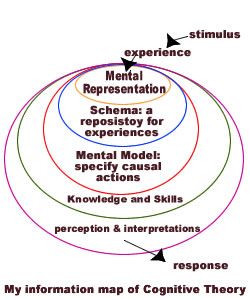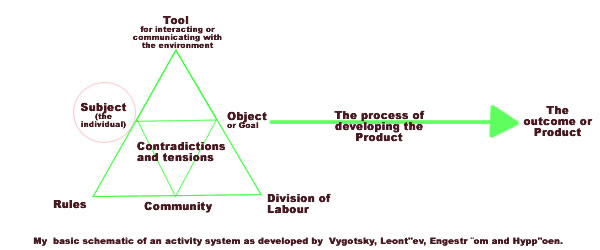Cognitive Theory and the Activity Theory
Written by Annette Devilee – prepared as part of the assessment for her Master of Learning Science and Technology (MLS&T) at The University of Sydney. 2008.
Cognitive Theory
Summary of chapter by Winn, W., (2004)
Where behaviorism spoke of stimulus and response (B. F. Skinner 1904-1990) ) the theory of Cognitive Development (J. Piaget, (1896-1980)) and the “cognitive revolution” introduced the idea of internal mental processes or states (such as beliefs, desires and motivations) that mediate between the stimulus and response. Cognitive Theory holds that our external environment is internalised as mental representations. These are not a replication of the external world but a representation; an Umwelt or our own internal version of the world. In our endeavours to understand the world these representations are organised into categories or structures called schemata (singular schema).
Schemata are memory structures, receptacles for mental representations, repositories for experiences. Schemata are an abstraction of experience, a higher mental level than the experience. They are in flux, changing and dynamic, as we assimilate new knowledge and make conceptual changes. These schemata influence our perception & interpretations of the world. Mental Models are broader than schema because they also specify causal actions. The construction of mental models helps us to understand systems and solve problems.
Learning can be seen as a modification of the existing schema or the creation of new schema due to new information or experiences. Comprehension and recall are improved when information is structured or organised.
Pictures or Graphics with text can facilitate understanding by defining structure (Winn, 2004. p. 88). Spatial organisation of information allows the student to remember more easily and associate with new information more easily. By constructing information maps we can make sense of the information in our own way.
 The development of expertise can be described as the development of sophisticated schemata or mental models. These highly internalised structures facilitate the effortless retrieval of information. As the learner progresses through the stages from novice to expertise, they are increasingly able to fuse decision making and action. As a student continues to practice and receive feedback beyond the level of mastery, their skills become more automatic. An expert has the ability to “see the big picture”. There are quantitative and qualitative differences between how the expert and novice structure their knowledge and skills.
The development of expertise can be described as the development of sophisticated schemata or mental models. These highly internalised structures facilitate the effortless retrieval of information. As the learner progresses through the stages from novice to expertise, they are increasingly able to fuse decision making and action. As a student continues to practice and receive feedback beyond the level of mastery, their skills become more automatic. An expert has the ability to “see the big picture”. There are quantitative and qualitative differences between how the expert and novice structure their knowledge and skills.
Interactive multimedia systems are effective tolls for model building (Hueyching & Reeves, 1992; Kozma, Russell, Jones, Marx, & Davis,1993; Seel & D¨orr, 1994; Windschitl & Andr’e, 1998). Computers can be used to develop models to represent ideas. Multimedia systems allow students to decide on their own strategies or structures.
We can view the CT as one where we acquire these mental representations or schema; the focus is on our internal representations.
Activity Theory
Summary of chapter by Barab, S. A., Evans, M. A., & Baek, E.-U. (2004)
More recently there has been a shift towards a focus on the external environment and our participation in a contextualised activity.
It was Vygotsky (1896-1934) who moved the focus of cognition and knowledge from the internal individual mind to the external contextual environment and since we share the environment with the others in our community our experiences, learning and knowledge become a collective shared process. Thus, this more recent theory has made a radical shift from the internal individual view of cognition to a more external sociocultural approach.
Vygotsky proposed a triadic relationship between the object of cognition (referred to as the stimulus by the behaviorists), the active subject (the respondent) and the tool (or instrument) that mediates the interaction between the object and subject. These tools are most commonly language or material items such as hammer or a computer but they can also be other ways of interacting, experiencing or communication with our environment such as signs, signals, or symbols. Vygotsky introduced the concept of Zone of Proximal Development (ZPD) . Learning here is collaboration between people and objects in the environment that are mediated by a tool as described above.
Leontev (1903-1979), took up this work to give greater emphasis on the object to which the activity is directed. The activity is motivated by this object. He also moved the focus from the action of individuals to the activity of collective work. Engestr¨om extended the triadic relationship to include rules, community and division of labor. He saw that all activities occur in a particular social or environmental context. He also introduced the concept of contradiction or tensions between all the elements of his extended triadic relationships. For him this is the primary concern of education; to balance or manage the tensions that arise with each contextualised activity. Taking this process of externalisation one step further Hypp’oen suggested the focus should be on the activity as it relates to the process of developing a result or product.

Barab, Evans, & Baek(2004) use slightly different terminology. They refer to the subject as the actor and the object as that which is acted upon. They are interested in Technology as the tool for informing and capturing the design of an activity, and for communication and collaboration with others. Through the process of design for social participation an artifact is developed.
Conlusions
Core assumptions about learning
- (CT) The student learns by forming mental representations. These mental representations are structured in schemas and mental models. Learning occurs when these mental models change quantitatively and qualitatively. This is an individual process.
- (AT) Learning is a mediated activity. Tools are used to mediate between the student and their learning goals. This is a collaborative process, a collectively shared process with social, cultural and historical dimensions.
Instructional design/teaching
- (CT) Teaching starts with the delivery of explicit and measurable instruction of facts and rules. It should then be followed by helping students to structure and organise their ideas; to make sense of it. This improves understanding and memory. Learning environments need to be adaptive to student actions; not predetermined.
- (AT) The teacher must first make an analysis of the the students to establish their actual development level. The teacher acts as the facilitator to encourage students to actively participate in the learning process and collaborate with peers. The teacher should pitch the work just above the student’s current level of understanding and provide a wide range of tools for the student to choose from. This process of guiding the student through the ZDP is known as scaffolding ; currently a popular concept in Australian education.
I do not see CT and AT as antagonistic theories. In many ways they can compliment each other for while one focuses on in the internal workings of the individual, the other focuses on the external activities of people with each other and their environment. Together they can give a more complete picture of the way we learn.
References
- Barab, S. A., Evans, M. A., & Baek, E.-U. (2004). Activity Theory as a lens for characterizing the participatory unit. In D. H. Jonassen (Ed.), Handbook of Research on Educational Communication and Technololgy (2 ed., pp. 199-214). Mahwah, NJ: Lawrence Erlbaum.
- Winn, W., (2004). Cognitive perspective in psychology. In D. H. Jonassen (Ed.), Handbook of Research on Educational Communication and Technololgy (2 ed., pp. 79-112). Mahwah, NJ: Lawrence Erlbaum.
- Wikipedia contributors (2006). Main Page. Wikipedia, The Free Encyclopedia. Retrieved 23:37, March 31, 2006 from http://en.wikipedia.org/w/index.php?title=Main_Page&oldid=46297907.
